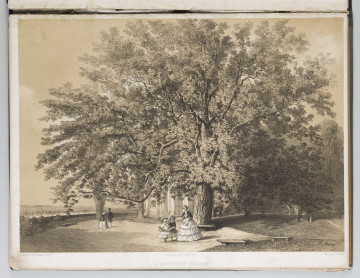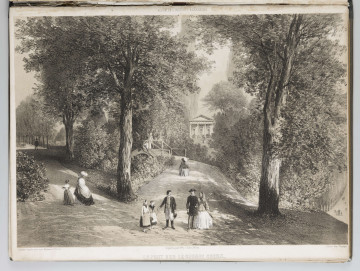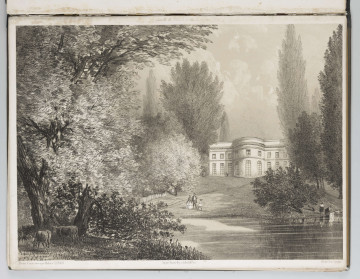
Le marronnier seculaire
1860
National Museum in Lublin
Part of the collection: Lubliniana. Painting views of Lublin and the Lublin Region (17th–early 20th c.)
In the second half of the 18th century the Czartoryski family created a cultural centre in Puławy known as the New Athens. Thanks to Duchess Izabela's initiatives, including the building of a national memorial shrine where she gathered priceless historical memorabilia, this place was a refuge of patriotic values during the partitions. The year 1831 ended the period of splendour of the residence. As a part of post-Uprising repressions the family property was confiscated, the ninety-year-old Duchess had to leave Puławy, and the name of the town was changed to New Alexandria. In 1842, the palace housed the Alexandrian Institute for the Education of Ladies, the equivalent of women's educational institutions in the Russian Empire, which operated until 1862. At the expense of the government, daughters of officers and officials were educated here, as well as girls preparing for the profession of a governess. The overriding idea of the educational system was Russification. The content of the curriculum served to develop admiration, obedience and attachment to the Russian monarchy.
In 1858, the Album des vues de l'Institut Alexandra du jardin et des environs de Novo Alexandra (Pulawy) dessiné d'après nature par Madame Czernof (Album of Views of the Garden of the Alexandrian Institute and the Surroundings of New Alexandria, Drawn from Nature by Madame Czernof) was published in Paris, containing a collection of twenty-four lithographs.
The author of the works, Barbara Czernof née Groten, was a drawing teacher at the Institute. Little is known about her artistic achievements. Her watercolour landscapes of Puławy and the surroundings: Parchatka, Janowiec, and Kazimierz are her only remaining legacy. The works represent a type of academic, historicizing landschaft with staffage, sentimental in expression and semi-amateur in technique.
The sheet Le Kiosque (The Pavilion) refers to the activities of the Institute. It depicts a vast view of the garden with a strange building in the background and a group of female students and teachers during outdoor activities. The girls in identical uniforms take a break from their walk to rest in front of the Chinese Gazebo. This small building, resembling a Chinese pagoda, was erected in the first half of the 18th century by Zofia née Sieniawska, Duchess Izabela's mother-in-law, and served as a tea house. The gazebo is picturesquely surrounded by trees, selected in accordance with the art of gardening, sometimes imported from distant parts of the world.
Author / creator
Dimensions
cały obiekt: height: 29,1 cm, width: 42,3 cm
Object type
graphics
Technique
lithography
Material
paper
Creation time / dating
Creation / finding place
Owner
The National Museum in Lublin
Identification number
Location / status

1860
National Museum in Lublin

1860
National Museum in Lublin

1860
National Museum in Lublin
DISCOVER this TOPIC
Castle Museum in Łańcut
DISCOVER this PATH
Educational path